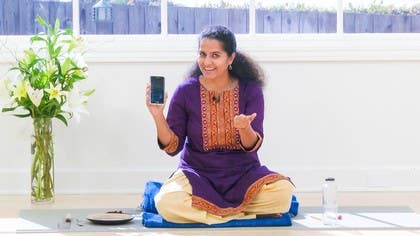Description
About This Video
Transcript
Read Full Transcript
Swagatam and welcome back. So let's try to start increasing our vocabulary in Sanskrit. Every language is founded on the vocabulary one has and the grammar rules that one knows about it. So when we put vocabulary and grammar together, we start building this rich structure of a language. What I'll do next is try to help you start understanding or recognizing the gender of a word and also teach you a few objects of daily life that you know when you are wanting to just practice and you want to use Sanskrit you can start just saying cha-ma-sa-ha for example. So a spoon is cha-ma-sa-ha. Sanskrit being primarily an auditory language or rather an oral language, I would suggest that we focus first on just absorbing the sound of the word and then we'll get into what it looks like in terms of the script. So there we are. So this is a cha-ma-sa-ha. You want to say that? Very good. Once together cha-ma-sa-ha. A glass cha-sha-ka-ha. Cha-sha-ka-ha. You want to say that? Let's do it together cha-sha-ka-ha. So that was cha-ma-sa-ha, cha-sha-ka-ha. The word for a brush is kur-cha-ha, kur-cha-ha. A kur-cha-ha is actually a brush in general. This is a hair brush. So the word for hair is kesha. You can combine that and make this a specific kesha-kur-cha-ha. Alright, that's another fun part of Sanskrit that you can really put words together and form more and more precise descriptions of the word you're talking about. So kur-cha-ha, a brush in general. Say that, kur-cha-ha. Fantastic. And now if you want to say hair which is kesha-ha, kesha-ha plus kur-cha-ha becomes kesha-kur-cha-ha. Say that kesha-kur-cha-ha. Brilliant. Now, so we had the word for spoon which was cha-ma-sa-ha, cha-sha-ka-ha, kur-cha-ha. Are you beginning to identify a pattern in that? Can you hear it? Cha-ma-sa-ha, cha-sha-ka-ha, kur-cha-ha.
If you watch the intro carefully, you would remember that all the words with masculine tend to have an ah-ha ending. It has a bit of a masculine feel about it. Ah-ha. Alright, do that, you'll get the energy right. So ah-ha. Yeah? Alright, so we repeat these. Cha-ma-sa-ha, kur-cha-ha, cha-sha-ka-ha. Now, I will give you the root of another word and you tell me what the ending would be like. So this is kantaka. That would be the root. Kantaka. What would it become? To identify it as a masculine word? Brilliant. Kantaka-ha. That's it. Kantaka-ha. Now, so you're all ready to eat. You have the cha-ma-sa-ha. I hope I've got it right. You see, in India we use the has-ta-ha, the hand and that serve as a fork and the knife and as everything for us. So we have that. Cha-ma-sa-ha, kantaka-ha, cha-sha-ka-ha, kur-cha-ha, has-ta-ha. Say that. Has-ta-ha. A bag. So it's sutta is the root form and what would it be? Perfect. Sutta-ha. Sutta-ha. Brilliant. Now, the thing that I'm sitting on the mat is also fortunately masculine here. So it's kat-ta-ha. Say that. Kat-ta-ha. Lovely. So we have looked at certain objects and we've also looked at a body part which is the hand. Another one that is very commonly used and that you would already know is the pa-da because you have a few asanas, the has-ta-pa-da-asana. So you have the has-ta which is a masculine, has-ta-ha and the foot which is pa-da-ha. Pa-da-ha can also mean the whole leg but it also often refers to the foot. So you have pa-da-ha, has-ta-ha and pa-da-ha. Lovely. A few other words, important words that are part of our daily life. The word for father for example is jhana-ka-ha. Jhana-ka-ha. I suggest you try and remember this particular word because we'll use it in the lessons to come. So jhana-ka-ha. A brother, sa-ho-da-ra-ha.
Sa-ho-da-ra-ha. Now I'll just use this particular word to give you a little insight into how the Sanskrit words are formed. The word sa-ho-da-ra-ha helps us understand how words are constructed in Sanskrit. So we have sa-ho-da-ra-ha which can be broken up into two parts. Sa-ha which means with, u-da-ra means the belly space. Alright. Sa-ha u-da-ra becomes sa-ho-da-ra-ha. So when we share the same belly space, then we are siblings and when you say sa-ho-da-ra-ha, it is your brother. So sa-ho-da-ra-ha. Father was jhana-ka-ha. Say that. Fantastic. And now the brother, sa-ho-da-ra-ha. Again. Fantastic. Two important words of the yoga tradition which are masculine, mantra-ha. Say that. Mantra-ha. I'll just draw your attention on the sound of this word. Very often I hear it spoken in English as mantra. But the original sound is mantra-ha. Say that and feel the vibration within. Mantra-ha. Fantastic. And now you know it's masculine as well. We have enough words in the feminine to compensate for the power. But don't worry about it. So another word that is important in yoga is prana-ya-ma-ha. Say that. Prana-ya-ma-ha. Not prana-ya-ma or something else. Prana-ya-ma-ha. Great. We'll just revise whatever we have seen thus far. We start with the cha-sha-ka-ha. I suggest I'll say it once and you repeat the second time. Alright. So cha-sha-ka-ha. Cha-ma-sa-ha. Fantastic. Kanta-ka-ha. Brilliant. Koor-cha-ha. Fantastic. Su-ta-ha. Fantastic.
Kata-ha. Terrific. At this stage we are going to go really fast. The word for hand is hasta-ha. Fantastic. Pa-da-ha. Ut-ta-ma-ma. Ut-ta-ma-ma is excellent in Sanskrit. The word for father is jana-ka-ha. Think of your father and use the word. It'll stick better. Jana-ka-ha. Very good. Brother, sa-ho-da-ra-ha. Fantastic. Now in the yoga tradition we had the mantra-ha and important breathing technique, prana-ya-ma-ha. Fantastic. Now we have seen that all these words end with aha and a masculine but a small warning there. You need to be a little careful because there are many words that have endings which are with different vowel sounds like uhu, like you have guru-hu for example, which is also a masculine word. And then you have another word for poet which is kavihi, again a masculine. And then there is the word yogi. Now the word yogi sounds like a feminine with an e ending but actually it's a masculine because we need to go back to the root which is yogin. In the masculine it becomes yogi but because the root word is yogin you can also have the feminine of this word which would be yogini. I hope you're there with me on this. I'll just repeat that for you. So when the word in the root form is yogin you want to represent it in the masculine it becomes yogi. The word yogin in the feminine becomes yogini. Right? And that's what helps us know what the root word is. I think that's a lot but just stay on a little patience like any language. The more you listen to it, the more you read it, the more easily you start absorbing it. Don't lose heart. I'll be there for you. Thank you.
Mother Tongue: Building Our Vocabulary
Comments
I thought that the root form or dhatu of a word was always a verbal form... like yuj is the root form for yoga and its derivatives... ( ? )
Hope this helps to bring some clarity in your understanding. Shubhamastu
You need to be a subscriber to post a comment.
Please Log In or Create an Account to start your free trial.










